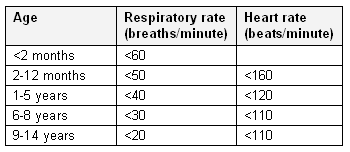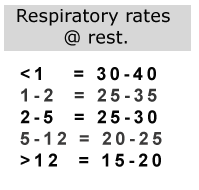Respiratory rates: textbook vs google. Who's right?
We’ve all been there; we’re trying to find the answer to a question and one book says one thing another book says another and Google has 7.1 million entries, whether it is electrolyte values, ECG measurements or simply respiratory rates for children, knowing what to trust is vital to student success.
To badly misquote “it’s all true, from a certain point of view”
What we have here are 2 separate but linked problems and I’m going to try and answer them both here.
The first problem is that of knowledge, and for these examples I’m going to stick with respiratory rates. You want to know the respiratory rate for an 8 year old. Okay, lets dig a bit deeper, why do you want to know the respiratory rate for an 8 year old? The chances are it is 1 of 3 things, you are learning normal values, you are studying for an exam where you expect a question on normal values or more likely both. When you look in a textbook you are probably faced with a table like this :

But in another text you find this table

And by this point you are really confused, so let’s go back and look at this again.
If you are learning normal values just to know what normal is, my advice is don’t!
Try to understand respiration as a whole and the second part of this answer will help with that.
If you are studying for an exam then it's slightly different. This is where this kind on knowledge is frequently tested especially in multiple choice questions (MCQ’s). For this one you need 1 very important piece of information. WHICH TEXT IS THE EXAM BASED ON because that’s the answer you need to memorise, if the exam is based on more than 1 text either one will trump the other (if so find out which) or the exam will be in a format where these variance’s are taken into consideration. A good example of this is the Pediatric Education for Prehospital Professionals (PEPP) course. All the answers come from the course textbook so even if there is a supplemental text, hand-outs or study guide with differing information the answers you need are in the text.
The second problem is centred on patient care, you want to know what the normal respiratory rate for an 8 year old is because you may have to assess and treat an 8 year old and you want to have an idea what normal is. Respiratory rates (RR) for age groups stated in texts are averages this is why they are normally given in ranges, you get age ranges and RR ranges and for easy of presentation they often come in tables.
In truth respiratory rates are a spectrum from birth to death based on any number of physiological factors WHICH CHANGE THROUGH TIME

For patient care what we really want to know is “Is the breathing I see in this patient effective?”
Effectiveness is made up of a number of different factors; respiratory rate, depth (tidal volume), rhythm and can be assessed in terms of patient perfusion as indicated by skin colour or by measurement i.e. pulse oximetry (see next week’s post for more on pulse oximetry)
The follow up question should be “How much effort is the patient making to achieve this level of perfusion?” This can been seen in the work of breathing, accessory muscle use and in paediatric patients tracheal tugging and intercostal recession
A third question would be “Is this work of breathing consistent with the history?” The 8 year old breathing at a rate of 44/min, tripoding, using all their accessory muscle having just run a half marathon is very different from the 8 year old breathing at a rate of 44/min, tripoding, using all their accessory muscle who has been at rest for the last half hour.
The final question, which brings us back full circle is “Are the respirations returning to normal?” WHAT IS NORMAL! You cry. Well normal is different for every patient but in general breathing should be autonomic, effortless and effective, if your patient has all 3 of those then I would say they are breathing normally.
